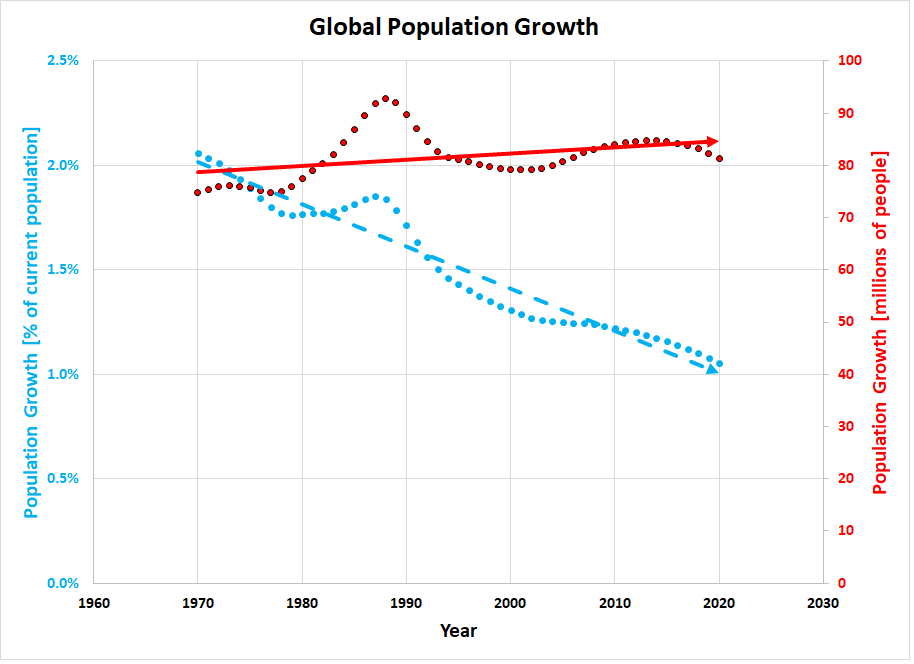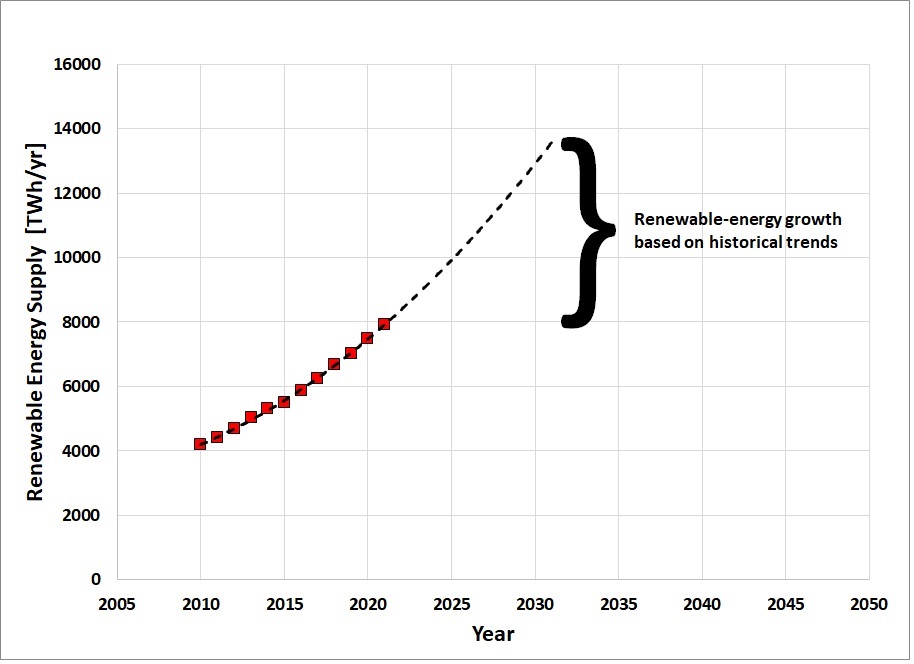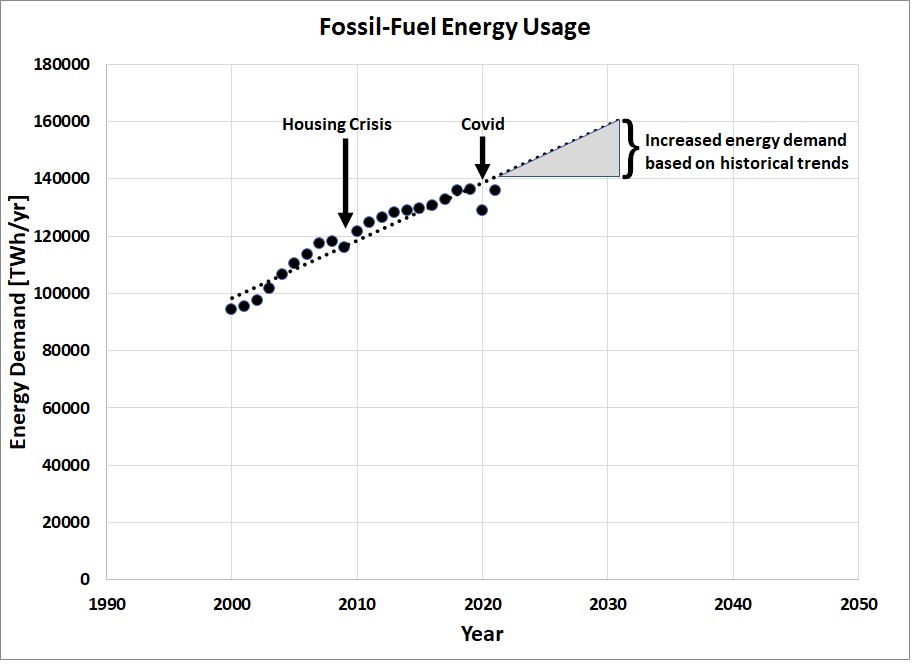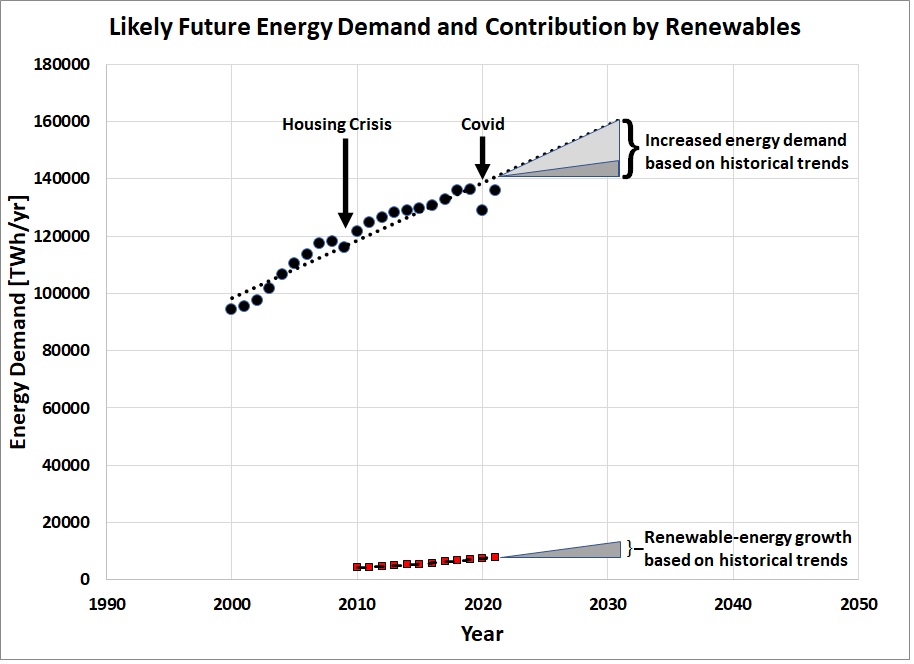
This paper demonstrates the peer review process that occurs at Skeptical Science. Several commenters in the comment thread pointed out an error in the analysis and made other suggestions. Whereas I suggest that renewables are likely to only contribute 30% of the near-term growth of electric-energy demand, in fact, renewables are likely to makeup all of the near-term growth in electric-energy demand. I will be redoing this paper to correct this error and to refine the analysis. However, the basic tenets of this paper will not change: 1) percentages can be used to hide the actual trend and 2) renewable energy is currently only supplementing, and not supplanting fossil fuels.
At a young age I learned that global population was increasing and worried about whether there would be sufficient resources for all of the new mouths added each year. I was relieved when I learned that overpopulation would be solved within my lifetime because population growth was decreasing. I put that problem out of my mind.
That was when the global population was 3 billion and I was naïve. Whether intentional or not, I had been snookered by the media because they were broadcasting population growth as a percentage of current population, shown in Fig. 1. In absolute terms, however, population growth has been increasing my entire life and we are still nowhere near solving this age-old problem (no pun intended).
This exemplifies how percentages can be misleading.

Figure 1. Annual, global population growth as a percentage of current population (dashed line) and as actual growth (solid line). Data is here.
Our “progress” towards reaching net-zero emissions is being communicated using methods that can similarly cloud our actual progress. We are awash with optimism about how well the energy revolution to renewable energy is going, at a time when global fossil-fuel usage is still increasing. An article in the New York Times (read here) recently noted that Europe already gets 22% of its energy from renewable sources and that globally renewable energy installations grew by 25% in 2022. Seemingly impressive numbers. At 25% growth/yr we might believe that Europe will be fully converted to renewable energy within a matter of years. Although it is unlikely such a revolution will occur that quickly in Europe, what is more important is understanding global trends, because that is ultimately what controls Global Warming/Climate Change (GW/CC) Let’s illustrate the problem using a simple example.
Figure 2 shows electricity generated from renewable energy, Fig. 3 shows trends for energy derived from fossil-fuels, and Fig. 4 compares energy demand over the next 10 years with that likely to be provided by renewable energy.

Figure 2. Renewable electricity generation during the recent, rapid growth of renewable energy. The continued rise over the next decade, based on historical trends, is also shown. Data is here,

Figure 3. Global fossil-fuel usage from 2000 onward, showing the temporary effects of the housing crisis and of Covid on energy usage. The continued increase over the next decade, based on historical trends, is also shown. Data is here.

Figure 4. Using data from Figs. 2 and 3, comparison of likely growth of energy demand (light gray triangular wedge), showing the fraction provided by renewable energy (dark gray triangular wedge). The dark-gray wedge is superimposed on top of the light-gray wedge to indicate that based on historical trends, that renewable energy growth will likely only provide about 30% of the increased energy demand over the next 10 years.
There are many ways to extrapolate trends into the future. The method I show in Figs. 2 to 4 is to simply extrapolate recent trends into the future. Whether or not this is what actually happens over the next 10 years is, of course, not known. But because this method is based on what we’ve actually been doing in the recent past, extrapolating recent trends over a short time frame going forward provides a good means for assessing and adjusting our plans if such analysis shows us coming up short of our goals. Because GW/CC is a global issue, the following analysis uses global data only.
As of 2021, Figs. 2 and 3 suggest ...
Therefore, renewable energy is currently supplementing, and not supplanting fossil fuels. However impressive it sounds to say that global renewable energy grew 25% in a single year, recent, historical trends indicate that the growth of renewables is not even keeping up with growing, global energy demand.
If we were to define an energy revolution as one where renewable energy begins to replace fossil-fuel use, leading to a steady reduction in fossil-fuel usage, then this simple analysis suggests that although we may be laying the groundwork for an energy revolution, it has yet to begin. Think about this the next time you step into the voting booth. Think about this the next time you make a decision about home heating, home power, or what type of car to buy.
Do you see how working with percentages, even impressive-sounding percentages, hides the real problem? Fossil-fuel consumption continues to grow and the current growth of renewable energy is not keeping up with, much less replacing fossil-fuel use. What will it take to get to net-zero emissions?
Because the hope is that we will do better in the future than we've done in the past, such projections need to be continually updated. The main point here is to not rely on isolated, impressive-sounding percentages, because they can easily hide the trends that matter, especially when they relate to regional trends only.
In 2022, the state of Texas in the US got 28% of its energy from renewables (read here). Thus, in 2022 Europe, with its reported 22% of electricity coming from renewables, is lagging behind one of the “oil capitals” of the world in terms of renewable-energy installations. If an oil-rich, Republican stronghold is ahead of Europe in the amount of energy it gets from renewables, perhaps this number of 22% is not as impressive as it sounds. Is it possible that the renewable energy in Texas is supplementing fossil-fuel generation rather than replacing it? Can the same be said for renewable-energy installations elsewhere? Has the shift from fossil-fuels to renewables really begun, or is the growth of renewable energy up to now merely providing surplus generating capacity to fuel our ever-expanding lust for power? In the context of our goals to reach net-zero emissions, how easy will it be to get to meaningful annual renewable percentages like 50%, 75% or more? Do a search on the percentage of the power created by renewables in any given geographical location. You will repeatedly find numbers in the range of 20-30%. If you read that such and such a place generated all of their electricity from renewables, it is usually only for a relatively short period of time. When averaged over an entire year, it is very difficult, without using energy storage, to generate more than about 30% of the energy from renewables. To get to net-zero emissions we must roll out renewable energy across the entire world, with energy storage, and simultaneously ramp down fossil-fuel use.
For those familiar with the business concept of “Crossing the Chasm”, what we’ve achieved so far can be likened to expanding renewable energy to early adopters. We’ve yet to cross the chasm to the mainstream: the rest of the world. Businesses sometimes fail because they project penetration of their product into the general market based on the rate of penetration into the early-adopter market. It may be that with renewable energy all that we’ve done so far is to pick the low-hanging fruit. To reach net-zero emissions, renewable energy must not only penetrate the general market, it must dominate the entire energy market and displace all existing, fossil-fuel based energy systems in a little over 25 years, if we’re to make our goal of reaching net-zero emissions by 2050.
The NYT’s article identifies the Chasm-Crossing problem as the cost of capital in emerging markets vs the cost of capital in developed countries.
“If you want to develop a solar project in Brazil or India, Birol said, you’re likely to pay three times more for financing than if you were to build the same project in Europe.
That has huge climate implications. The energy demands of these big emerging economies are growing fast. If they can’t finance renewables, they’ll turn to gas instead. Or worse, to coal.”
There is a somewhat different problem in China. Although China is clearly a leader in developing and deploying renewable energy, their motivation likely has less to do with a desire to lessen the impacts of GW/CC and more to do with their own development goals. China is running out of water with which to cool traditional fossil-fueled power plants that have traditionally been behind their rapid economic expansion. Is renewable energy in China supplanting or supplementing existing fossil-fueled power plants?
At the same time, there is a strong push to transition to EV’s in to ease local pollution. It is much easier in China to get a license to operate an EV in a large city than to operate a gas-powered vehicle. The rise of EVs in China may not represent a decrease in emissions associated with people decreasing use of gas-powered vehicles, but rather an increase in the total number of vehicles. Because EV’s have a carbon footprint, albeit lower than gas-powered vehicles, whether there is a net drop in carbon emissions associated with increasing EV sales in China will depend on whether the decrease in operation of gas-powered vehicles outpaces the increase in EV’s.
Be careful about assuming that a growth in renewable energy and EVs in China implies a decrease in carbon emissions. The situation is more complex.
Posted by Evan on Wednesday, 15 February, 2023
 |
The Skeptical Science website by Skeptical Science is licensed under a Creative Commons Attribution 3.0 Unported License. |